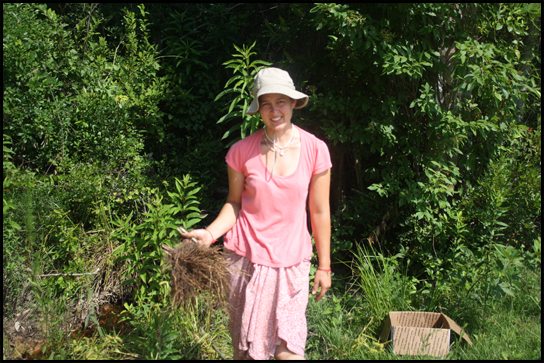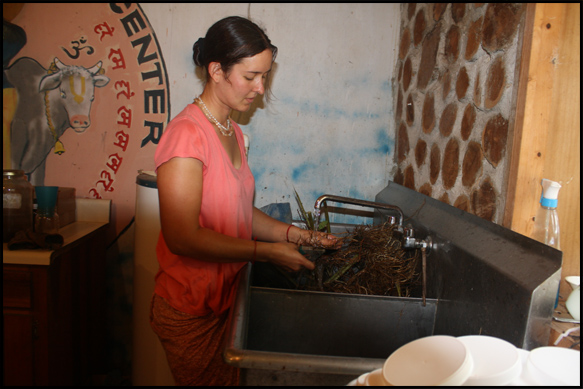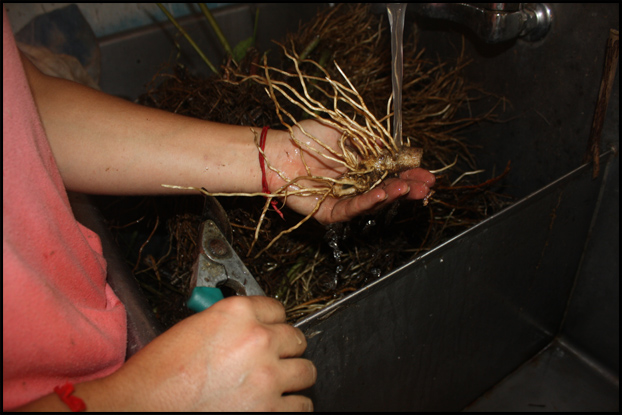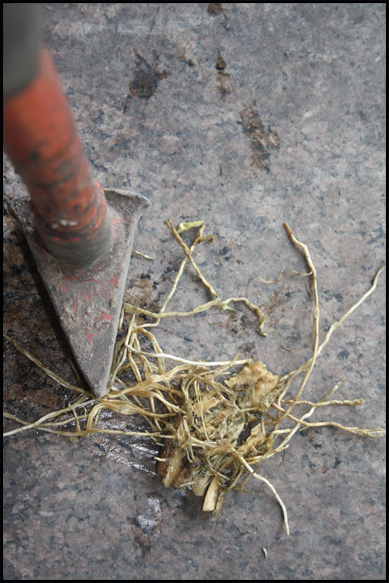EUPATORIUM PURPUREUM
Gravel Root
Botanical Description: This plant is herbaceous, with a perennial ,horizontal woody caudex. With many long , dark brown fibers, which send up one or more solid, glabrous, green, sometimes purplish stems, 5 or 6 feet high with a purple band at the joints about an inch broad. The leaves are from 3 to 6 in a whorl about 6 inches apart, oblong-ovate, or lanceolate, pointed, rugosely or feather-veined, coarsely serrate, slightly scabrous, with a soft pubescence beneath along the mid-vein and vein-lets, thin, soft, borne on petioles an inch long and from 8 to 12 inches , by 3 or 4 inches wide. The flowers are all tubular, purple or pinkish-purple, varying to whitish, and consist of numerous florets included in an 8-leaved calyx. The heads are in lax, very dense and compound corymbs of a cylindrical form, and from 5 to 10 flowered.
Medicinal Action and Personal Reflection: When digging the root it looks very much like a large spider. It has a very peculiar odor not exactly unpleasant but sort of sweetish, yet at the same time rather earthy. It will be found mostly in wet grounds in the South, sometimes even in swampy situations. It spreads rather quickly by roots when mowed. It is by no means invasive however and makes a very nice addition to a wet garden.


The root is the part used and should be dug in the late fall if possible, however it is very potent at all stages of growth, but maximum potency would be when the juices have died down for winter. Sometimes when digging you will see an older root connected to a newer one. It is best to spot it however when in bloom because in the winter it will look just like many other plants such as wild lettuce especially to the novice. Although at closer examination one could make the distinction.
Gravel root has many common names to indicate both its botanical appearance and also its medicinal uses. It is called Queen of the meadow because it stands so high and the purple hue of its flowers make it somewhat majestic in appearance. It is called Joe Pye weed because one native American of that name used it extensively in his practice. It is called Gravel root because it has the ability to remove and to a certain degree dissolve kidney stones or gravel. It is a member of the large boneset family of herbs, many of which are well none for their medicinal value. Gravel root is underused in medicine today because most people just think of it for removing kidney stones and overlook its other uses especially in the genito-urinary tract of women.


This lead was derived in Kings for its use in the reproductive disorders of women because of its ability to restore the uterine tonicity. It specifically refers to its use in retro version, prolapsus, introversion, etc, all conditions where dysplasia has occurred. This could be a cause of sterility and that condition is what I originally had success in with Gravel root. I combined it with black cohosh and squaw vine in a case of long standing sterility with good success. This is a well documented case where the lady was under the care of an expert midwife and much effort had failed. I personally knew the lady and while contemplating her situation remembered her having a car wreck where she broke her hip among other things. Although the accident was many years removed, when reading about sterility caused by dysplasia and similar conditions, I thought that this might be the cause of sterility in this case, as she was otherwise a very health conscious person who had tried all available means. After taking the Gravel root about a month or two she conceived. The midwife was convinced that it made the difference. Since I have used it in many cases and thus far have always been satisfied. So much so that the word spread of our success in this regard and one day a lady called who had heard about the use of the herbs for conception and left a message on my machine saying she had heard that I was good at making women get pregnant. I had to laugh wondering what my wife would think about this new profession I was taking up. I called the lady and jokingly told her that actually I didn’t make people pregnant but had some herbs that she could use.


I now combine gravel root with White water lily, Nymphaea Odorata, because of its use in restoring a healthy condition to the uterine tissue due to its astringent action. I add squaw vine to this combination and in this way we have had good success. Of course there are many herbs that can be added to this but this formula has been good for us in uterine difficulties including endometriosis and any condition where the uterus need restoring. More will be said about the other herbs in this formula under their title.


Gravel roots use in urinary complaints goes without saying. It is quite famous and I have seen it work in almost all urinary complaints. I combine it with Button snake root for burning urination with much success. It can be combined with Groundsel for blood in the urine or milky colored urine.
It is most famous because it is used to dissolve kidney stones. It of course combines well with Hydrangea in this regard. The larger stones are difficult for any herb to act quickly, but gravel root will definitely work as good as any and if persisted in will move the small ones and gradually work on the larger ones. It may take sometime, but it will do the job even on the large ones eventually. If passing stones, it is advised to take Uva Ursi to help make the passage easier also. Although just recently I saw a case where the combination of Gravel root, Hydrangea and Button snake root cause stones to pass quickly with tolerable discomfort. Of course I say tolerable, but I didn’t have to feel it. It did however rive the condition and the advise would be to continue its use to prevent stones in those people who are more disposed to get them.


Gravel should be thought of in all disorders of the urinary tract. It is a very efficient diuretic and is indicated in bed wetting. Gravel root is useful in pregnancy when a cough dispels urine.
Gravel root is very safe and the dosage can be increased according to the condition. For normal diuretic use the dosage of 15 to 30 drops is usually very helpful. In our experience the dosage in quantity is not the most important aspect of medical application, but the frequency of dosage. The normal dosage of 15 to 30 drops, probably the 30 drops would be minimum for an adult and should be repeated as many as 6 times a day in acute conditions. This will result in a much more active result and hasten the healing. Gravel root has no toxicity so the dosage can be quite large without fear.


Gravel root is they type of herb which sometimes will draw a following, like the comfrey syndrome in which the herb develops an almost cult type of following. It is a wonderful herb and does so many things in urinary complaints and thus when it is first experienced the results make a believer sort of like seeing a miracle and then becoming a follower. All herbs are ultimately like this of course, it is just that when one is able to see the quick result then one becomes faithful. However, this tendency to think that one herb is a cure all generally becomes tempered when we experience the variegated array of wonderful healing agents created by the Supreme Artist.
